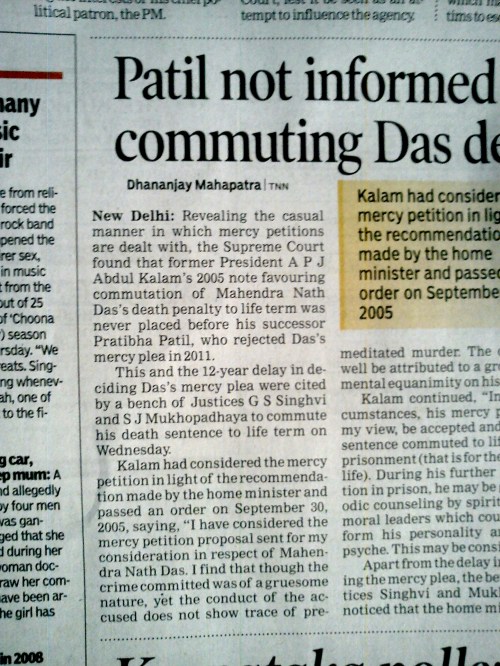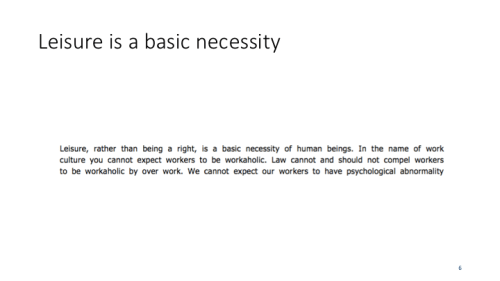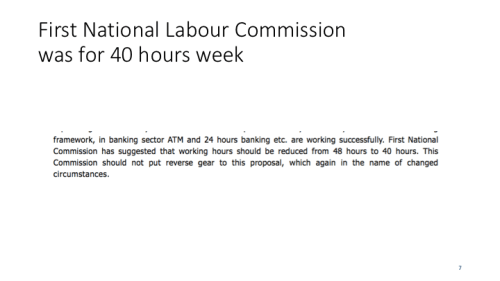It’s Heaven! The venue is the Durbar hall of Lord Yama Dharma Raja. He had summoned the souls both from the heaven and the hell to discuss the hullabaloo around the draft Labour Code circulated by the Ministry of Labour & Employment in India, on 16.04.2017. The entire assembly is full and the crowd is overflowing outside the Durbar Hall too to watch the proceedings, which are telecast live too throughout the universe. Sir William Beveridge, who had given the monumental report on Social Security, Prof. B.P. Adharkar, the Father of Social Security in India, and other stalwarts on social security were the special invitees of the meet. Now, the proceedings!

Lord Yama Dharma Raja: “Dear Mr. Beveridge ! What is going on in India? I find there are protest marches in Chattisgarh about some Labour Code? The issue is spreading around, I am told. What is the problem?
Beveridge: My Lord ! The ultra-rich club in India is becoming more and more vicious. They are finding newer and newer methods to loot the common people. The present set of rulers are much more obliging to them than the previous rulers. That is the cause of all the problems in India, now.
Lord: Ultra-rich? What is it?
Beveridge: My Lord ! 1% of Indians have cornered for themselves 53% of the wealth of the nation. They are the ultra-rich. And, they want to covet even more. The rulers are happy to oblige this greedy rich, for quid pro quo, and betray the trust reposed in them by the common people. These rulers want the votes of these commoners to remain in power. But, they do have no compunction to cheat these commoners by colluding with the rich and ultra-rich to enable the later to loot the commoners. The proposed Labour Code is yet another example of the manner in which the rulers go out of the way to please their ultra-rich monsters, sorry, masters. That is the reason for the social tumult in the offing in India.


Lord: What is that Labour Code, after all?
(Adharkar rises up to respond to this question)
Adharkar: My Lord! We had already discussed on 26.09.2015 about the manner in which the rulers under obligation to the ultra-rich went extra mile to amend the Sec. 44 of the ESI Act, 1948 to facilitate privatisation of social security in India. (https://flourishingesic.info/2015/09/26/lord-yama-dharma-raja-discusses-amendment-to-sec-44/). But, they could not succeed in their attempt because the employees’ representatives in the supreme body of the ESI Corporation became alert to see through the game plan of the rulers. The employees’ representatives had voiced their protest so vehemently that the rulers beat a hasty retreat on 07.04.2015 in the meeting of the supreme body. (https://flourishingesic.info/2015/04/05/kind-attention-esi-corporation-members-please-ask-these-questions-on-07-04-2015/). So, they found a way around. Now, instead of trying to tinker with Sec. 44 of the ESI Act, they are going to club together as many as 15 labour welfare legislations including among them the ESI Act and the EPF Act and remove the important benefits provided under the ESI Act. They believe that people would not notice their mischievous intentions and the loss of benefits under the ESI Act when they mix all the laws together and take away the benefits provided under the ESI Act.
(At this stage Margaret Thatcher, former Prime Minister of the UK chips in. The Lord looks at her.)
Thatcher: My Lord, What Mr.Adharkar says is true. When I was the Prime Minister of the UK, there was a BBC serial titled, “Yes, Minister”. I used to keep aside all my routine work and watch that serial everyday. It explained to the people and politicians how the bureaucrats used to cheat the politicians in power. The senior bureaucrat, Sir Humphrey, in that serial would train his junior in that art. He would  advice his junior that if he wanted to something wrong, he must do things in a complicated way so that the people would not understand anything. ”If people don’t know what you’re doing, they don’t know what you’re doing wrong.” But, on going through the draft Labour Code circulated by the Ministry of Labour of the Government of India, that the said advice of Sir Humphrey is used by the politicians and bureaucrats of India to cheat the common people. It is a matter of shame that India which was given independence from the British control goes the wrong way in running the nation. It becomes clear from the text of the draft Labour Code that the nation is going away from civilised way of social life. I was discussing about it with Mr. Jerome Blanqui, the great French economist of the early 1800s. His ideas contributed a lot to the evolution of formal law-making by various states on social security. He is also of the same opinion about this draft Labour Code. The present government of India is helping the greedy rich to exploit the labour class and keep them poor perennially. I am sad at these developments in India”.
advice his junior that if he wanted to something wrong, he must do things in a complicated way so that the people would not understand anything. ”If people don’t know what you’re doing, they don’t know what you’re doing wrong.” But, on going through the draft Labour Code circulated by the Ministry of Labour of the Government of India, that the said advice of Sir Humphrey is used by the politicians and bureaucrats of India to cheat the common people. It is a matter of shame that India which was given independence from the British control goes the wrong way in running the nation. It becomes clear from the text of the draft Labour Code that the nation is going away from civilised way of social life. I was discussing about it with Mr. Jerome Blanqui, the great French economist of the early 1800s. His ideas contributed a lot to the evolution of formal law-making by various states on social security. He is also of the same opinion about this draft Labour Code. The present government of India is helping the greedy rich to exploit the labour class and keep them poor perennially. I am sad at these developments in India”.
(The Lord looks at Jerome Adolphe Blanqui, whose great treatise, ‘History of Political Economy in Europe – From the ancients to our day’, published in 1837 AD, was a remarkable milestone in the evolution of Social Security).
Jerome Blanqui: “Yes, My Lord ! Every society is supposed to move forward to a civilised state. I was fortunate enough to have been born in France where great souls who fought for liberating the humanity had been born and had worked for it. Voltaire, Rousseau and Montesquieu liberated not only France from the tyrants but also the entire humanity from slavish men tality. French intellectuals considered that production was “not” something that was “independent of the fate of the workers”. I have stressed the fact that “it is not sufficient for (a nation) that wealth be created, but it must be equitably distributed”. In the view of our French intellectuals, “men are really equal before the law as before the Eternal. The poor are not a text for declamations, but a portion of the great family, worthy of the deepest solicitude”, care and concern. But, I find that the present day rulers of India are moving in a diametrically opposite direction. The nation will, then, be a den of poverty and misery, with the working class having no real right to live a dignified life as they will be treated as ‘commodity’ by the rulers.
tality. French intellectuals considered that production was “not” something that was “independent of the fate of the workers”. I have stressed the fact that “it is not sufficient for (a nation) that wealth be created, but it must be equitably distributed”. In the view of our French intellectuals, “men are really equal before the law as before the Eternal. The poor are not a text for declamations, but a portion of the great family, worthy of the deepest solicitude”, care and concern. But, I find that the present day rulers of India are moving in a diametrically opposite direction. The nation will, then, be a den of poverty and misery, with the working class having no real right to live a dignified life as they will be treated as ‘commodity’ by the rulers.
Beveridge: The intention of the present day rulers to make the working class a pawn in the hands of the employers has already become public, in the year 2014 itself. Yet, the public has not been awakened to their sinister designs. It was on 07.08.2014, that these rulers introduced a Bill for increasing the spread-over time from 10 and half hours to 12 hours, for enabling the employers to force the workers to work for about 10 hours a day, to compel women workers to work during night hours, etc., That would prove that India is on the path of retardation while other nations like Germany move forward towards reduced work hours which result in more production.
Blanqui: What is more? These rulers were sadistic enough to call that bill as the Bill for safety and health of workers.
The present Labour Code is also yet another sadistic piece. This is intended to relieve the State of its obligation to provide social assistance in the form social insurance. Common people will, however, be told that it is an effort towards “simplification, amalgamation and rationalisation”. The rulers would cover up their mischievous intentions by propagating that the Labour Code was to extend the benefits to unorganised labour including the household workers. But, the real intention is to reduce the benefits provided by the ESI Corporation and enable the private players enter into the field of social security and make a mess of it. Commercialisation of social security will result in complication of the process and deprivation of various benefits to the working population. My Lord, kindly ask for the details from Mr. Robert Owen, who is regarded as the Father of Social Security of the World. He did not only plead for the intervention of the governments of various nations to step in and enact laws for the welfare of the workers, but also for international agreement between various nations for enacting such laws. Mr. Louis Rene Villerme, the great physician, who worked tirelessly for the welfare of the working class and their working conditions in 1800s, would throw more light on it. So many illustrious figures had been fighting and canvassing for about 100 years for State intervention to safeguard the living conditions of the working class. All their efforts culminated in various labour laws from 1923 to 1952 in India, overseen by the government. But, all these developments are attempted to be consigned to dustbin by one single Labour Code.
Lord: How?
Adharkar: Yes, My Lord! In the name of amalgamation, the draftsmen of the Labour Code have seen to it that many time-tested benefits provided under the ESI Act vanish into thin air. The ESI Act provides a bouquet of benefits. But, the bouquet has been meddled with in the Labour Code and individual benefits have been separated and are made to be chosen by every employee, telling him that his contribution would be dependent on the nature and number of benefits he wants. That is why the words “not exceeding” have been incorporated in Sec. 20.1 of the Labour Code, while specifying the quantum of contribution payable by the employer.
Lord: In that case, have they made known to the people that the benefits would not be a package but would have to be picked and chosen by the workers?
Adharkar: No, My Lord ! The draftsmen know what they are going to do but are suppressing the complete picture from being shown to the workers.
Lord: Why do they do so?
Adharkar: If they make their intentions or goals known to the public, they would not be able to privatise the social security scheme, as the public would oppose it. They will not, then, be able to please the businessmen who want to enter into the field to make money by squeezing the workers. That is why they say only a few things in the Labour Code and try to acquire power to the rulers to do many things, which are against the workers, through sub-ordinate legislations. When people ask about them, they say that they have not prepared those subordinate legislations yet. They have many such subordinate legislations in mind, like, Rules, Regulations, Schemes, Bye-Laws, Licences, etc., But, they say that they have not prepared them yet.
Lord: Is it necessary to prepare the subordinate legislations also along with the Code?
Adharkar: No, My Lord ! Subordinate Legislations can be prepared later. But, the primary legislation which empowers the executive to prepare subordinate legislations must be a self-explanatory one informing the people about the goal and purpose of the legislation. The need is more so, when the rulers want to replace the existing legislations. They have the right to compare the present position with the promised scenario in its entirety. But, the rulers do not want to give complete picture to the people, of their proposed legislations.
Lord: Can the rulers do so?
Adharkar: No, My Lord ! They cannot. There is a Legislative Department under the Ministry of Law & Justice. “The drafting of Bills” is the work of the officials of this department (http://lawmin.nic.in/more.htm). The letter dated 24.04.2017 of the Ministry of Labour shows that they do have a “Drafting Team”. That Drafting Team should have been given some directions, in writing, to prepare the Labour Code. It is those directions which would enlighten the people what is in store for them. But, the rulers do not make it public.
Lord: Okay, but when the rulers do not make something public, why do you presume that the Code would be anti-labour?
Adharkar: It is not my presumptions My Lord! There are indications in the draft Labour Code itself that the intentions of the rulers or the Drafting Team are sinister. Besides, the procedure of drafting legislations require the rulers to entrust the Drafting Team with the ‘legislative policy’. Mr. Justice. M. Jagannadha Rao, Chairman of the 17th Law Commission of India, has written a paper on Legislative Drafting. He says, “The draftsman is not the author of the legislative policy, he merely tries to transform the legislative policy into words. The legislative policy is made by the political executive which belongs to the political party which is ruling the legislature or by the monarch who reigns over the country. The draftsman must, therefore, digest the legislative policy fully before he produces the instrument of legislation which can achieve the legislative purpose”. The issue here with the Labour Code is why the Drafting Team does not make the concerned ‘legislative policy’ public. That shows that their intention is mala fide. The wordings of the draft Labour Code also testify to the existence of such mala fide intention. People do not know what benefits would be there for them and what would not be.
(John Foster McCreight, the first Premier of British Colombia and then judge of the Supreme Court raises his hand. The Lord nods at him)
McCreight: My Lord ! The procedure of law-making is the same the world over. “Drafting legislation is an art, not a science. A well-drafted bill results, not from slavishly following numerous arbitrary rules, but rather from thorough knowledge of the subject, careful attention to detail, and adherence to such commo n-sense principles as simplicity, clarity and good organization. In drafting legislation, British Columbia legislative counsel have two goals: (1) to construct legislation that g
n-sense principles as simplicity, clarity and good organization. In drafting legislation, British Columbia legislative counsel have two goals: (1) to construct legislation that g
ives legal effect to government policy; (2) to communicate the law clearly to the people who are affected by it, the officials who administer it and the judges who interpret it.” Satisfying both goals is often difficult, but that has to be, necessarily, done for every law. “Legislative counsel write law based on the drafting instructions they receive from the sponsoring ministry”. It is simply shocking to find the draft Labour Code of India suffering from various infirmities. I wonder how they want the public to opine on it when it is incomplete and contains so many grammatical errors too, besides serious gaps in “communicating the law clearly to the people who are affected by it”.
Lord: Do you think that the government officials would also cheat the public, because the rulers in power direct them to do so?
Adharkar: My Lord ! The bureaucracy in India is a class apart. Sir Humphrey, the fictional character in ‘Yes, Minister’ is nowhere near them, in cunningness. They would cheat not only the people but also the President. They would disobey the President himself, if his decision is not to their liking. They would, therefore, go to any length to please the bosses they like and cheat the people.
Lord: Surprising ! Can the civil service be so?
Thatcher: My Lord ! It is so in India.
Abdul Kalam: My Lord ! Let me narrate an incident. One Mahendra Nath Das was imposed death penalty by the Supreme Court. He sent mercy petition to the President of India. I happened to be the President at that time. The mercy petition was placed before me in the year 2005 and I commuted the death penalty to life term. Later in the year 2013, I came to know through newspapers that so many things happened in that case. The order issued by me in the file in the year 2005 had not been enforced. The bureaucrats had kept the file pending for years. It was later put up before my successor Pratiba Patil in the year 2011, and she rejected the mercy petition. She was not informed of the decision taken by me in the year 2005. If she had been informed, she would not have taken that decision. Moreover, there was no scope in office procedure to suppress th e factum of my order to obtain another order from the President. Yet, the central bureaucrats had indulged in that mischief. It came to light in 2015 when the Supreme Court of India examined the case filed before it by the person who faced the gallows. So, Indian bureaucracy cannot be expected to be trusted blindly. They must be kept in check, by effectively making use of the Right to Information Act and by strengthening it further, instead of weakening it.
e factum of my order to obtain another order from the President. Yet, the central bureaucrats had indulged in that mischief. It came to light in 2015 when the Supreme Court of India examined the case filed before it by the person who faced the gallows. So, Indian bureaucracy cannot be expected to be trusted blindly. They must be kept in check, by effectively making use of the Right to Information Act and by strengthening it further, instead of weakening it.
(The Lord Yamadharma Raja was stunned at the revelation by Dr. Abdul Kalam. He feels concerned about his own problems as the Lord of Justice. He looks at Chitragupta).

Chitragupta: Yes, My Lord ! If only that Mahendra Nath Das had been sent to gallows in 2011, after the rejection of the mercy petition by Pratiba Patil, it would have made our work difficult. It will be difficult for us to decide whether Das was guilty of the crime committed by him or the victim of the crime committed by the bureaucrats who cheated the President to cause his mercy petition rejected. If we have to punish him for his guilt we must send him to hell. If he is considered as the victim of the conspiracy hatched by the Indian bureaucrats we must send him to heaven and reserve the hell for those bureaucrats. We will have to weigh the pros and cons very minutely My Lord!
(The Lord nods his head in approval. He is in deep thoughts).
Lord: Okay, okay ! I am convinced that the Indian bureaucracy at the centre can be cunning to any extent. Now, may I know what they are doing with this Labour Code?
Adharkar: Firstly, My Lord ! Wherever the ESI Act is there, there will be no need for the Employees’ Compensation Act (formerly, Workmen’s Compensation Act, 1923). But, in this Code, the provisions of the Employees’ Compensation Act are retained in Part I (Sec. 61 to 75 ) and some of the very important provisions of the ESI Act, 1948 have been totally omitted. How can the Drafting Team call the draft Labour Code a process of ‘amalgamation’?
Lord: What are those provisions of the ESI Act omitted to be brought to the Labour Code?
Adharkar: Sec. 51-B to Sec. 51-E My Lord! They have totally omitted these benefits. They do not reply when asked who advised them to do so. This is a very serious conspiratorial measure agains the working population by the Drafting Team and the rulers.
Lord: I understand. Are other provisions okay?
Adharkar: No, My Lord! The Labour Code had reduced the quantum of compensation payable to the person who sustained Employment Injury. The Code assures only 50% as per the EC Act and not 90% as per the ESI Act. A scrutiny of Sec. 63 reveals this fact. This section is only the reiteration of the provision of the EC Act. The benefit provided by the ESI Act is not assured here through the Code. It has been left open-ended depending on the mercy of the rulers. Sec. 63 (1) (a) (b) which has the phrase “whichever is more” indicates that the Executive is at liberty to increase or decrease the rate of Dependant’s Benefit. The continuation of the present 90% of wages (roughly) as Dependants’ Benefit is not assured. How can people give approval to such a legislation My Lord!
Beveridge: Is it because the ESI Act does also have that provision only in the Rule and not in the Act?
Adharkar: Mr. Beveridge! When the ESI Act was enacted for the first time, the quantum of all these benefits were assured in the Act (as The First Schedule), before seeking the approval of the Parliament. Now, when the rulers want to replace the present ESI Act, they cannot play hide and seek with people. What is the difficulty for them in shifting the quantum of benefit of Dependants’ Benefit from the ESI (Central Rules) to the Code itself? More so, when they have shifted the quantum of contribution from Rule 51 of the ESI (Central) Rules ( a subordinate legislation) to the Labour Code (a primary legislation) directly?
Lord: Why do they do so?
Adharkar: The authorities do maintain a cunning silence in this regard, My Lord! They have not attached any Notes to the draft Labour Code explaining why they included something and excluded others. They do not show the draft ‘Statement of Objects and Reasons’ too. They cannot, therefore, be trusted, My Lord!. The rumour is that they might not provide Dependants Benefit equivalent to the present one in future, @ 90%, to facilitate entry of private players in the market of Social Security and enable them to make a lot of profit.
Lord: When the ESIC is paying the Dependants Benefit @90% does is suffer any loss?
Adharkar: No, My Lord ! ESIC was showing surplus consistently. A social security organisation must have such strong surplus. The funds were kept only in government securities.
Lord: Is such a surplus necessary?
Adharkar: Yes, My Lord ! Adequate surplus in an insurance against Anxiety, says the Noble Prize Winner Economist Paul Krugman. It is essential in the insurance field. The surplus in the ESIC was not a flab. Moreover, such a surplus got generated from the 1950s when the ESIC had Chapter VI, providing for Employers’ Special Contribution, collected from all over the nation from the employers who were not in the implemented area. Moreover, the ESIC was managing its funds best, My Lord ! This was appreciated by the newspaper Economic Times too in February 2003. The system of managing funds was improved in the subsequent four years, by collecting daily offer from various nationalised banks every afternoon and deposting the money with them in Savings Bank account, instead of Current Account. The method was marvellous My Lord!. But, these essential facts are either not understood by the elements which run down the ESIC or they pretend not to know that. Because, their motive in bringing the Labour Code is ulterior, My Lord!
Lord: I understand. When will the earthlings mature? What is the reason for the desperate efforts taken now to privatise social security in India in such a cunning manner?
Adharkar: My Lord, the ESI Corporation cannot give any corporate donations to the political parties. So, there is no real gain for the rulers to run the ESIC right. They, therefore, choose to run it down. There had been vicious campaign against the ESIC and the EPFO from 28.02.2015 onwards, when the Finance Minister presented his budget stating, in an arbitrary and unauthorised manner, that these organisations were holding the employees as hostages. When asked under the RTI Act, no Ministry could explain how such an allegation found a space in the Budget speech.
The agents of the money sharks are working over time since then to campaign against these organisations through numerous articles in various newspapers including the Hindustan Times and the Forbes. My Lord, Indian society is going the wrong way. The humanity is going to suffer a lot unless the mala fide designs of the politicians-businessmen-middlemen-bureaucrats nexus is exposed before the public. There are so many mischievous portions in the Labour Code, My Lord! They do not want to examine the disastrous consequence of similar steps taken in Peru and Chile. They are hell bent on obliging the money sharks who want to enter into the insurance field and loot the people who draw upto Rs. 21000 pm. That is the reason for this unseemly hurry in bringing out this Labour Code, in such a peremptory manner.
Lord: Yeah! Let us analyse them deeply tomorrow!
(Lord Yamadharma Raja rises up. The assembly is dissolved)
(Contd.)
Images: Courtesy, Wikipedia














 advice his junior that if he wanted to something wrong, he must do things in a complicated way so that the people would not understand anything. ”If people don’t know what you’re doing, they don’t know what you’re doing wrong.” But, on going through the draft Labour Code circulated by the Ministry of Labour of the Government of India, that the said advice of Sir Humphrey is used by the politicians and bureaucrats of India to cheat the common people. It is a matter of shame that India which was given independence from the British control goes the wrong way in running the nation. It becomes clear from the text of the draft Labour Code that the nation is going away from civilised way of social life. I was discussing about it with Mr. Jerome Blanqui, the great French economist of the early 1800s. His ideas contributed a lot to the evolution of formal law-making by various states on social security. He is also of the same opinion about this draft Labour Code. The present government of India is helping the greedy rich to exploit the labour class and keep them poor perennially. I am sad at these developments in India”.
advice his junior that if he wanted to something wrong, he must do things in a complicated way so that the people would not understand anything. ”If people don’t know what you’re doing, they don’t know what you’re doing wrong.” But, on going through the draft Labour Code circulated by the Ministry of Labour of the Government of India, that the said advice of Sir Humphrey is used by the politicians and bureaucrats of India to cheat the common people. It is a matter of shame that India which was given independence from the British control goes the wrong way in running the nation. It becomes clear from the text of the draft Labour Code that the nation is going away from civilised way of social life. I was discussing about it with Mr. Jerome Blanqui, the great French economist of the early 1800s. His ideas contributed a lot to the evolution of formal law-making by various states on social security. He is also of the same opinion about this draft Labour Code. The present government of India is helping the greedy rich to exploit the labour class and keep them poor perennially. I am sad at these developments in India”. tality. French intellectuals considered that production was “not” something that was “independent of the fate of the workers”. I have stressed the fact that “it is not sufficient for (a nation) that wealth be created, but it must be equitably distributed”. In the view of our French intellectuals, “men are really equal before the law as before the Eternal. The poor are not a text for declamations, but a portion of the great family, worthy of the deepest solicitude”, care and concern. But, I find that the present day rulers of India are moving in a diametrically opposite direction. The nation will, then, be a den of poverty and misery, with the working class having no real right to live a dignified life as they will be treated as ‘commodity’ by the rulers.
tality. French intellectuals considered that production was “not” something that was “independent of the fate of the workers”. I have stressed the fact that “it is not sufficient for (a nation) that wealth be created, but it must be equitably distributed”. In the view of our French intellectuals, “men are really equal before the law as before the Eternal. The poor are not a text for declamations, but a portion of the great family, worthy of the deepest solicitude”, care and concern. But, I find that the present day rulers of India are moving in a diametrically opposite direction. The nation will, then, be a den of poverty and misery, with the working class having no real right to live a dignified life as they will be treated as ‘commodity’ by the rulers.
 n-sense principles as simplicity, clarity and good organization. In drafting legislation, British Columbia legislative counsel have two goals: (1) to construct legislation that g
n-sense principles as simplicity, clarity and good organization. In drafting legislation, British Columbia legislative counsel have two goals: (1) to construct legislation that g e factum of my order to obtain another order from the President. Yet, the central bureaucrats had indulged in that mischief. It came to light in 2015 when the Supreme Court of India examined the case filed before it by the person who faced the gallows. So, Indian bureaucracy cannot be expected to be trusted blindly. They must be kept in check, by effectively making use of the Right to Information Act and by strengthening it further, instead of weakening it.
e factum of my order to obtain another order from the President. Yet, the central bureaucrats had indulged in that mischief. It came to light in 2015 when the Supreme Court of India examined the case filed before it by the person who faced the gallows. So, Indian bureaucracy cannot be expected to be trusted blindly. They must be kept in check, by effectively making use of the Right to Information Act and by strengthening it further, instead of weakening it.





